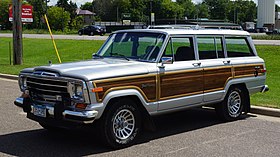| Jeep Wagoneer | |
|---|---|
 1990 Jeep Grand Wagoneer (SJ) | |
| Overview | |
| Manufacturer |
|
| Also called | |
| Production | 1962 – June 1991 |
| Model years | 1963–1991 |
| Assembly | |
| Designer | Brooks Stevens, Dave Nutting |
| Body and chassis | |
| Class | Full-size luxury SUV |
| Body style |
|
| Layout | Front engine, rear-wheel drive / four-wheel drive |
| Platform | Full size (SJ) Jeep platform |
| Related | |
| Powertrain | |
| Engine |
|
| Transmission | |
| Dimensions | |
| Wheelbase | 110 in (2,794 mm) [3] |
| Length | 186.4 in (4,735 mm) |
| Width | 74.8 in (1,900 mm) |
| Height | 66.4 in (1,687 mm) |
| Curb weight | 4,514 lb (2,048 kg) |
| Chronology | |
| Predecessor | Willys Jeep Station Wagon |
| Successor | |
The Jeep Wagoneer is a luxury 4x4 produced and marketed under the Jeep brand from the 1963 to 1991 model years.[4] Introduced as the replacement for the Jeep Station Wagon, the Wagoneer was the first Jeep model line completely distinct from the Jeep CJ.[5] Designed as a truck-based station wagon, the model line became a progenitor of the modern sport-utility vehicle (SUV).
Designed under contract by industrial designer Brooks Stevens,[6] the exterior of the Wagoneer was styled by engineer Dave Nutting. Sharing the Jeep SJ chassis (full-size Jeep) with the Jeep Gladiator/J-Series, the Wagoneer also shared its underpinnings with the introductory Jeep Cherokee.
In 1966, Jeep introduced the high-content Super Wagoneer, upgrading the model line with features from higher-priced sedans.[7][8] Though the trim was short-lived, the Wagoneer became upgraded in content and features throughout the 1970s. For 1984, the Jeep Grand Wagoneer was introduced (to distinguish the SJ from the smaller XJ Wagoneer), becoming its flagship trim.
Through its 29-year production under a single generation (the third longest in U.S. automotive history[9]), the Wagoneer underwent only nominal changes to its body structure and appearance. The model line was produced by Jeep through its ownership by Kaiser Jeep, AMC, and Chrysler.
For 1993, Jeep revived the Grand Wagoneer nameplate as a flagship trim of the Jeep Grand Cherokee, again using its exterior wood trim. The nameplate remained dormant for 31 years until the introduction of the WS-chassis Wagoneer/Grand Wagoneer (the largest Jeep SUVs ever produced).
- ^ "Pars Khodro in history" (PDF). Archived from the original (PDF) on 12 March 2012. Retrieved 23 July 2014.
- ^ "1962 Jeep Wagoneer brochure". Oldcarbrochures.com. Retrieved 23 July 2014.
- ^ "1962 Jeep Wagoneer brochure – specifications". Oldcarbrochures.com. Retrieved 23 July 2014.
- ^ Truesdell, Richard (31 August 2004). "Move Over, Range Rover" (PDF). Retrieved 15 December 2023.
- ^ "Survivors: The world's longest-living cars - Jeep Wagoneer/Grand Wagoneer (1963-1991) – 28 Years". Autocar. 23 January 2020. Retrieved 15 December 2023.
- ^ "1963-1992 Jeep Wagoneer and Grand Wagoneer". auto.howstuffworks. 29 August 2007.
- ^ Korfhage, Jered (16 October 2020). "1966 Jeep Super Wagoneer: Looking Back: Precursor to Luxury". Four Wheeler. Retrieved 20 February 2021.
- ^ Printz, Larry (1 October 2020). "The first luxury SUV? It wasn't the Range Rover". Hagerty. Retrieved 20 February 2021.
- ^ "Grand Wagoneer". Road & Track. Vol. 43. 1992. p. 214.